THE ROLE OF THE
THE ROLE OF THE
THE ROLE OF THE
Create successful ePaper yourself
Turn your PDF publications into a flip-book with our unique Google optimized e-Paper software.
5<br />
5.1 IntroductIon<br />
Manufacturing and<br />
Process Technology<br />
This book was written from the perspective of the OEM (original equipment manufacturer)<br />
chemist. Thus, manufacturing or processing for various plastics, elastomers,<br />
or metals is not discussed in detail, although some time should be devoted to it.<br />
Often, the OEM chemist or material engineer is required to interface with raw material<br />
suppliers and chemists from tier one or tier two suppliers regarding processing<br />
and how best to manufacture the product of interest. We will briefly touch on some<br />
of the most important and useful technologies for the chemist today. The discussion<br />
centers on some of the key processes and technologies within this book.<br />
5.2 rubber ProcessIng<br />
Rubber processing can be considered to take place in four steps: mixing, forming, storing,<br />
and molding. During the mixing process, heat applied to the rubber will cause the<br />
rubber to go through various states of flow. Below the T g (the glassy region), the polymer<br />
chains are frozen in place. The material is highly elastic and molecular motion is<br />
limited to bending and stretching. At the glass transition region (T g), rotational motion<br />
increases and the polymer is very viscous. In the rubbery region, the polymer is highly<br />
elastic and rubber like, which will allow for elongation. In this region, chains develop<br />
entanglements that act like cross-links. Finally, in the flow region, at the highest temperatures,<br />
resistance to translational motion decreases and the chains slip easily past<br />
one another. Viscous flow is now possible, dimensional stability is lost, and the material<br />
can be compounded using mixers, rubber calendar machines, and curing presses.<br />
Finished products will no longer flow because they are now cross-linked.<br />
Rubbers must first be mixed. They consist of various components that provide a<br />
specific function to the compound. A typical rubber compound has the components<br />
listed in Table 5.1. To mix the components, a Banbury mixer is often used. These<br />
types of mixers have been in use since 1916 [1]. A Banbury will have two spiral<br />
blades held within a housing and is considered an internal mixer. The two blades<br />
of the mixer will have channels for heating and cooling if necessary. Between the<br />
blades is a ridge or space for the material to be mixed. The invention of the Banbury<br />
resulted in the removal of roller milling in rubber production [2]. Figure 5.1 shows<br />
a rough schematic of the internal Banbury type mixer. For a typical tire batch of<br />
225 kg, a Banbury mixer has a gross capacity of around 270 L and operates at up to<br />
2,000 hp [3].<br />
67







